Flinders University MMED9111: Pharmacology Clinical Case Analysis
VerifiedAdded on 2023/06/10
|10
|2913
|320
Case Study
AI Summary
This assignment presents a series of clinical cases requiring analysis of potential or actual medication-related issues. Case 1 examines the administration of Rosuvastatin and Cephalexin, highlighting concerns about side effects and appropriate dosages for cellulitis treatment. Case 2 focuses on a patient with acute renal failure, scrutinizing the use of ibuprofen and other medications. Case 3 addresses Parkinson's disease management with Sinemet, emphasizing dosage titration and potential adverse effects of Metoclopramide. Case 4 reviews the use of Warfarin and Digoxin in a patient with interstitial lung disease and atrial fibrillation, questioning their appropriateness. Finally, Case 5 discusses Phenytoin dosage adjustments and potential toxicity in a patient with epilepsy. Each case emphasizes critical evaluation of drug choices, dosages, and potential interactions.
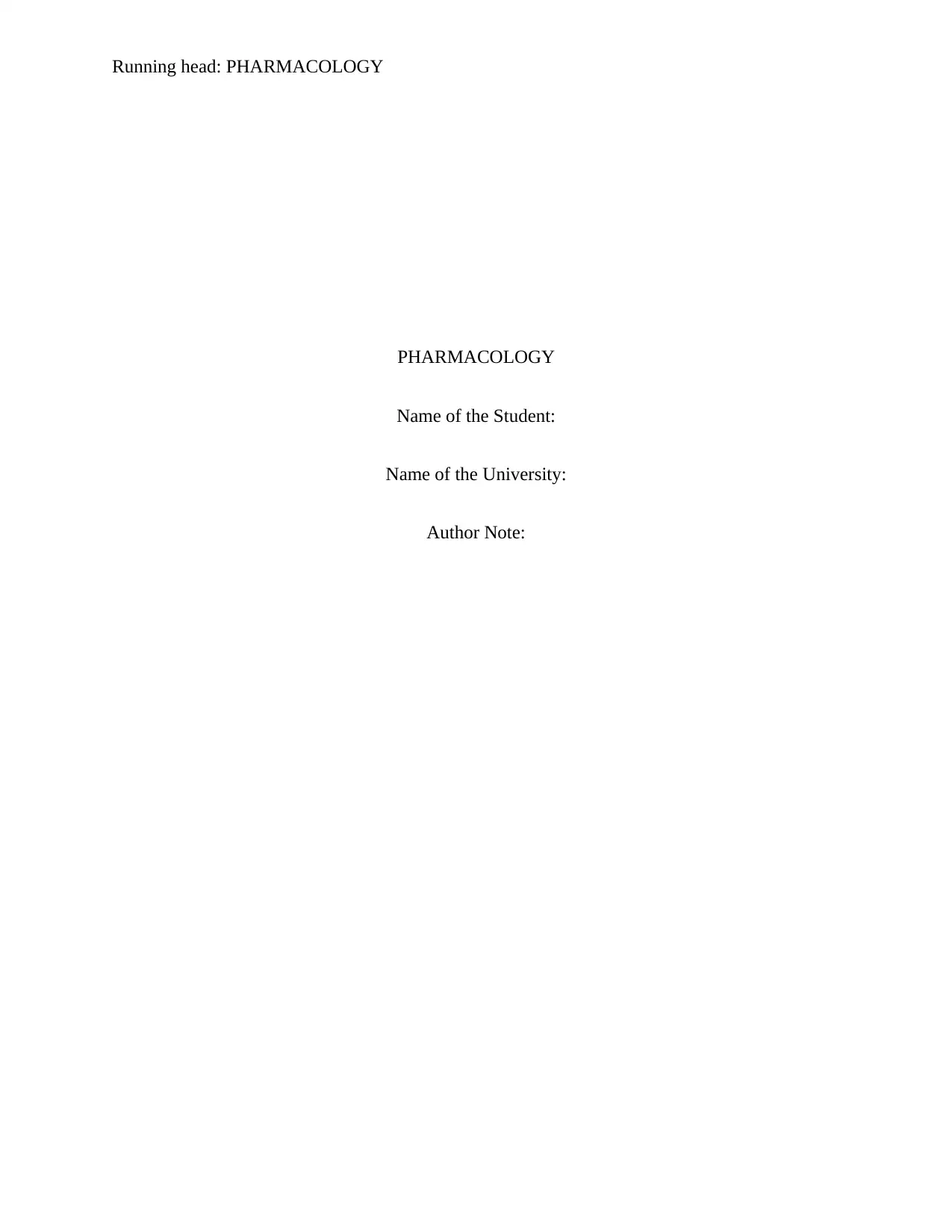
Running head: PHARMACOLOGY
PHARMACOLOGY
Name of the Student:
Name of the University:
Author Note:
PHARMACOLOGY
Name of the Student:
Name of the University:
Author Note:
Secure Best Marks with AI Grader
Need help grading? Try our AI Grader for instant feedback on your assignments.
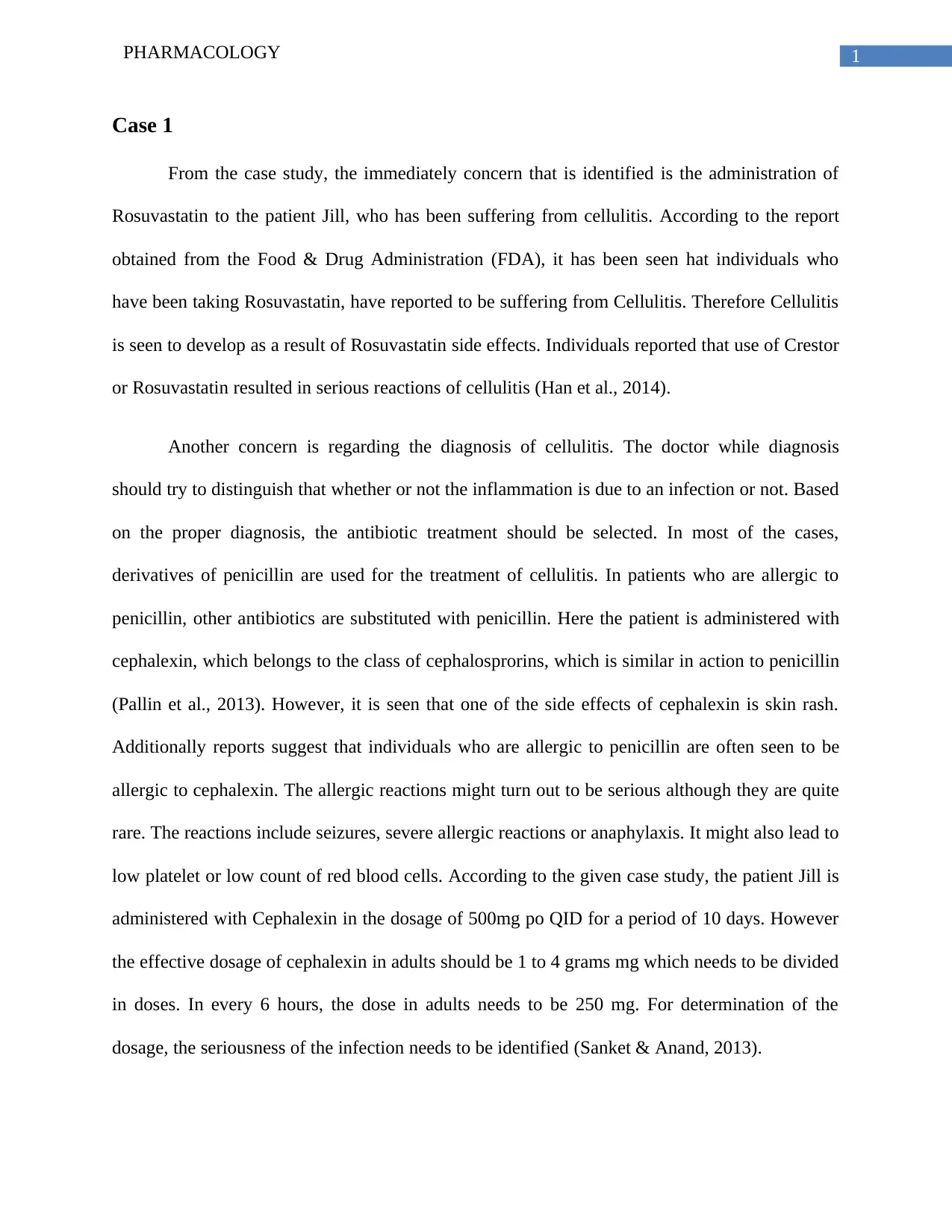
PHARMACOLOGY 1
Case 1
From the case study, the immediately concern that is identified is the administration of
Rosuvastatin to the patient Jill, who has been suffering from cellulitis. According to the report
obtained from the Food & Drug Administration (FDA), it has been seen hat individuals who
have been taking Rosuvastatin, have reported to be suffering from Cellulitis. Therefore Cellulitis
is seen to develop as a result of Rosuvastatin side effects. Individuals reported that use of Crestor
or Rosuvastatin resulted in serious reactions of cellulitis (Han et al., 2014).
Another concern is regarding the diagnosis of cellulitis. The doctor while diagnosis
should try to distinguish that whether or not the inflammation is due to an infection or not. Based
on the proper diagnosis, the antibiotic treatment should be selected. In most of the cases,
derivatives of penicillin are used for the treatment of cellulitis. In patients who are allergic to
penicillin, other antibiotics are substituted with penicillin. Here the patient is administered with
cephalexin, which belongs to the class of cephalosprorins, which is similar in action to penicillin
(Pallin et al., 2013). However, it is seen that one of the side effects of cephalexin is skin rash.
Additionally reports suggest that individuals who are allergic to penicillin are often seen to be
allergic to cephalexin. The allergic reactions might turn out to be serious although they are quite
rare. The reactions include seizures, severe allergic reactions or anaphylaxis. It might also lead to
low platelet or low count of red blood cells. According to the given case study, the patient Jill is
administered with Cephalexin in the dosage of 500mg po QID for a period of 10 days. However
the effective dosage of cephalexin in adults should be 1 to 4 grams mg which needs to be divided
in doses. In every 6 hours, the dose in adults needs to be 250 mg. For determination of the
dosage, the seriousness of the infection needs to be identified (Sanket & Anand, 2013).
Case 1
From the case study, the immediately concern that is identified is the administration of
Rosuvastatin to the patient Jill, who has been suffering from cellulitis. According to the report
obtained from the Food & Drug Administration (FDA), it has been seen hat individuals who
have been taking Rosuvastatin, have reported to be suffering from Cellulitis. Therefore Cellulitis
is seen to develop as a result of Rosuvastatin side effects. Individuals reported that use of Crestor
or Rosuvastatin resulted in serious reactions of cellulitis (Han et al., 2014).
Another concern is regarding the diagnosis of cellulitis. The doctor while diagnosis
should try to distinguish that whether or not the inflammation is due to an infection or not. Based
on the proper diagnosis, the antibiotic treatment should be selected. In most of the cases,
derivatives of penicillin are used for the treatment of cellulitis. In patients who are allergic to
penicillin, other antibiotics are substituted with penicillin. Here the patient is administered with
cephalexin, which belongs to the class of cephalosprorins, which is similar in action to penicillin
(Pallin et al., 2013). However, it is seen that one of the side effects of cephalexin is skin rash.
Additionally reports suggest that individuals who are allergic to penicillin are often seen to be
allergic to cephalexin. The allergic reactions might turn out to be serious although they are quite
rare. The reactions include seizures, severe allergic reactions or anaphylaxis. It might also lead to
low platelet or low count of red blood cells. According to the given case study, the patient Jill is
administered with Cephalexin in the dosage of 500mg po QID for a period of 10 days. However
the effective dosage of cephalexin in adults should be 1 to 4 grams mg which needs to be divided
in doses. In every 6 hours, the dose in adults needs to be 250 mg. For determination of the
dosage, the seriousness of the infection needs to be identified (Sanket & Anand, 2013).
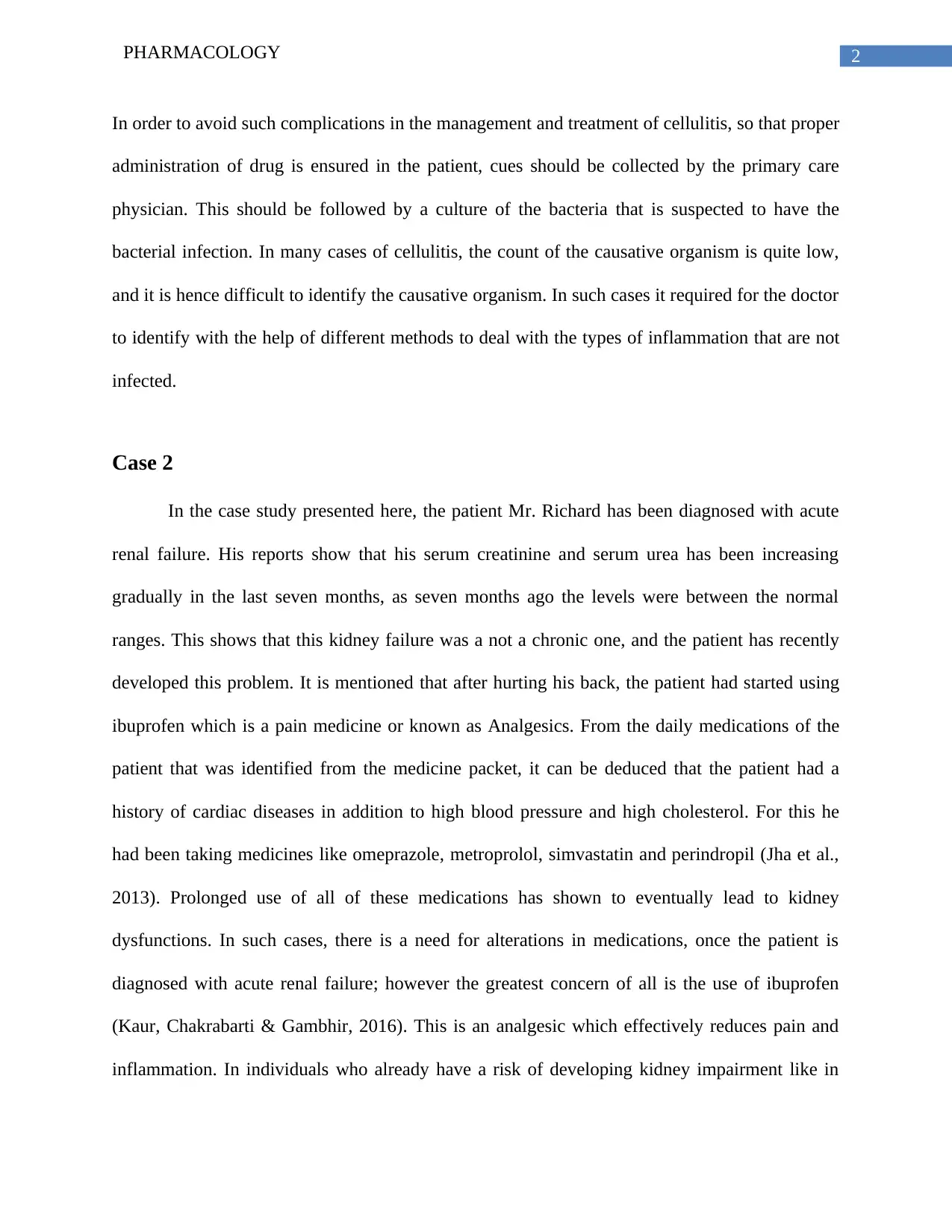
2PHARMACOLOGY
In order to avoid such complications in the management and treatment of cellulitis, so that proper
administration of drug is ensured in the patient, cues should be collected by the primary care
physician. This should be followed by a culture of the bacteria that is suspected to have the
bacterial infection. In many cases of cellulitis, the count of the causative organism is quite low,
and it is hence difficult to identify the causative organism. In such cases it required for the doctor
to identify with the help of different methods to deal with the types of inflammation that are not
infected.
Case 2
In the case study presented here, the patient Mr. Richard has been diagnosed with acute
renal failure. His reports show that his serum creatinine and serum urea has been increasing
gradually in the last seven months, as seven months ago the levels were between the normal
ranges. This shows that this kidney failure was a not a chronic one, and the patient has recently
developed this problem. It is mentioned that after hurting his back, the patient had started using
ibuprofen which is a pain medicine or known as Analgesics. From the daily medications of the
patient that was identified from the medicine packet, it can be deduced that the patient had a
history of cardiac diseases in addition to high blood pressure and high cholesterol. For this he
had been taking medicines like omeprazole, metroprolol, simvastatin and perindropil (Jha et al.,
2013). Prolonged use of all of these medications has shown to eventually lead to kidney
dysfunctions. In such cases, there is a need for alterations in medications, once the patient is
diagnosed with acute renal failure; however the greatest concern of all is the use of ibuprofen
(Kaur, Chakrabarti & Gambhir, 2016). This is an analgesic which effectively reduces pain and
inflammation. In individuals who already have a risk of developing kidney impairment like in
In order to avoid such complications in the management and treatment of cellulitis, so that proper
administration of drug is ensured in the patient, cues should be collected by the primary care
physician. This should be followed by a culture of the bacteria that is suspected to have the
bacterial infection. In many cases of cellulitis, the count of the causative organism is quite low,
and it is hence difficult to identify the causative organism. In such cases it required for the doctor
to identify with the help of different methods to deal with the types of inflammation that are not
infected.
Case 2
In the case study presented here, the patient Mr. Richard has been diagnosed with acute
renal failure. His reports show that his serum creatinine and serum urea has been increasing
gradually in the last seven months, as seven months ago the levels were between the normal
ranges. This shows that this kidney failure was a not a chronic one, and the patient has recently
developed this problem. It is mentioned that after hurting his back, the patient had started using
ibuprofen which is a pain medicine or known as Analgesics. From the daily medications of the
patient that was identified from the medicine packet, it can be deduced that the patient had a
history of cardiac diseases in addition to high blood pressure and high cholesterol. For this he
had been taking medicines like omeprazole, metroprolol, simvastatin and perindropil (Jha et al.,
2013). Prolonged use of all of these medications has shown to eventually lead to kidney
dysfunctions. In such cases, there is a need for alterations in medications, once the patient is
diagnosed with acute renal failure; however the greatest concern of all is the use of ibuprofen
(Kaur, Chakrabarti & Gambhir, 2016). This is an analgesic which effectively reduces pain and
inflammation. In individuals who already have a risk of developing kidney impairment like in
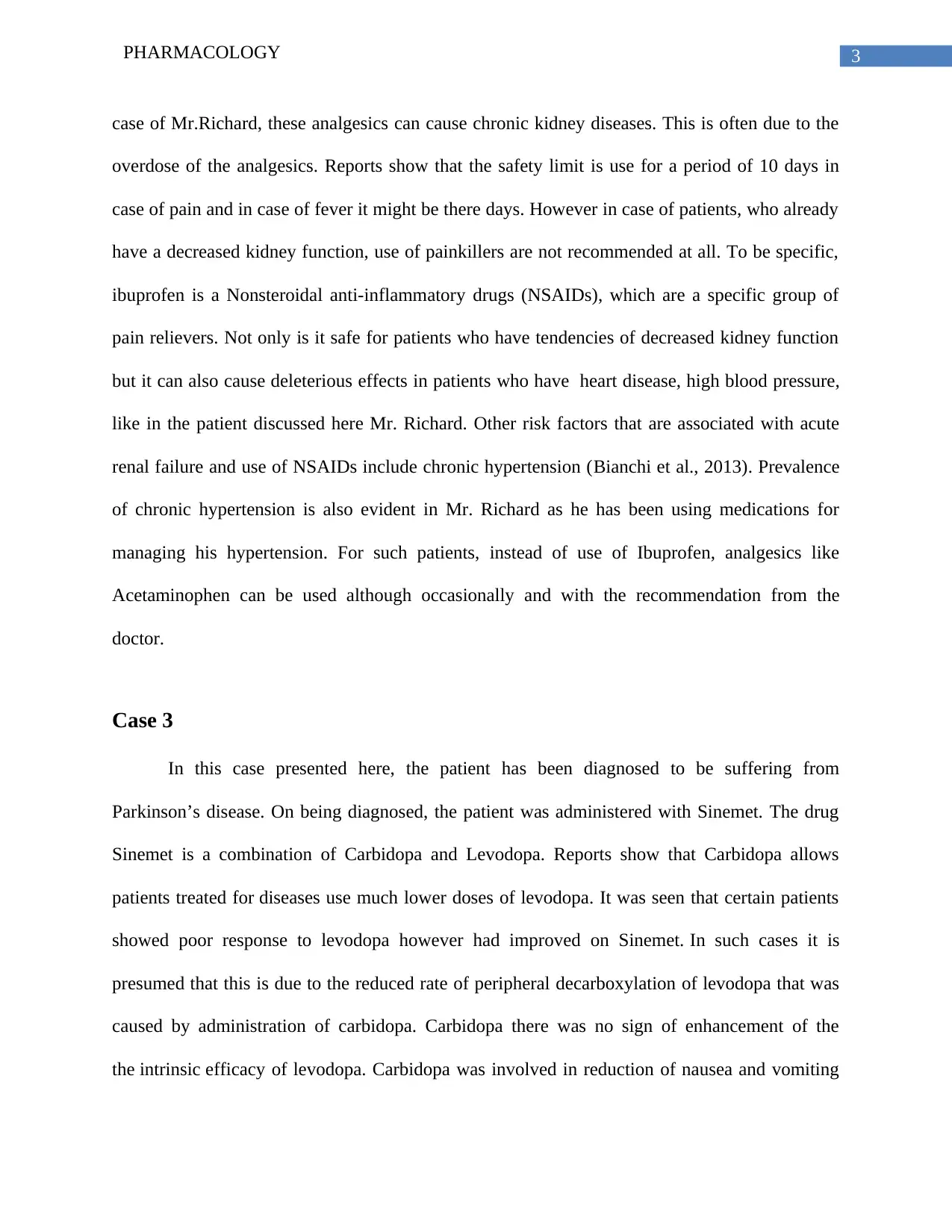
3PHARMACOLOGY
case of Mr.Richard, these analgesics can cause chronic kidney diseases. This is often due to the
overdose of the analgesics. Reports show that the safety limit is use for a period of 10 days in
case of pain and in case of fever it might be there days. However in case of patients, who already
have a decreased kidney function, use of painkillers are not recommended at all. To be specific,
ibuprofen is a Nonsteroidal anti-inflammatory drugs (NSAIDs), which are a specific group of
pain relievers. Not only is it safe for patients who have tendencies of decreased kidney function
but it can also cause deleterious effects in patients who have heart disease, high blood pressure,
like in the patient discussed here Mr. Richard. Other risk factors that are associated with acute
renal failure and use of NSAIDs include chronic hypertension (Bianchi et al., 2013). Prevalence
of chronic hypertension is also evident in Mr. Richard as he has been using medications for
managing his hypertension. For such patients, instead of use of Ibuprofen, analgesics like
Acetaminophen can be used although occasionally and with the recommendation from the
doctor.
Case 3
In this case presented here, the patient has been diagnosed to be suffering from
Parkinson’s disease. On being diagnosed, the patient was administered with Sinemet. The drug
Sinemet is a combination of Carbidopa and Levodopa. Reports show that Carbidopa allows
patients treated for diseases use much lower doses of levodopa. It was seen that certain patients
showed poor response to levodopa however had improved on Sinemet. In such cases it is
presumed that this is due to the reduced rate of peripheral decarboxylation of levodopa that was
caused by administration of carbidopa. Carbidopa there was no sign of enhancement of the
the intrinsic efficacy of levodopa. Carbidopa was involved in reduction of nausea and vomiting
case of Mr.Richard, these analgesics can cause chronic kidney diseases. This is often due to the
overdose of the analgesics. Reports show that the safety limit is use for a period of 10 days in
case of pain and in case of fever it might be there days. However in case of patients, who already
have a decreased kidney function, use of painkillers are not recommended at all. To be specific,
ibuprofen is a Nonsteroidal anti-inflammatory drugs (NSAIDs), which are a specific group of
pain relievers. Not only is it safe for patients who have tendencies of decreased kidney function
but it can also cause deleterious effects in patients who have heart disease, high blood pressure,
like in the patient discussed here Mr. Richard. Other risk factors that are associated with acute
renal failure and use of NSAIDs include chronic hypertension (Bianchi et al., 2013). Prevalence
of chronic hypertension is also evident in Mr. Richard as he has been using medications for
managing his hypertension. For such patients, instead of use of Ibuprofen, analgesics like
Acetaminophen can be used although occasionally and with the recommendation from the
doctor.
Case 3
In this case presented here, the patient has been diagnosed to be suffering from
Parkinson’s disease. On being diagnosed, the patient was administered with Sinemet. The drug
Sinemet is a combination of Carbidopa and Levodopa. Reports show that Carbidopa allows
patients treated for diseases use much lower doses of levodopa. It was seen that certain patients
showed poor response to levodopa however had improved on Sinemet. In such cases it is
presumed that this is due to the reduced rate of peripheral decarboxylation of levodopa that was
caused by administration of carbidopa. Carbidopa there was no sign of enhancement of the
the intrinsic efficacy of levodopa. Carbidopa was involved in reduction of nausea and vomiting
Secure Best Marks with AI Grader
Need help grading? Try our AI Grader for instant feedback on your assignments.
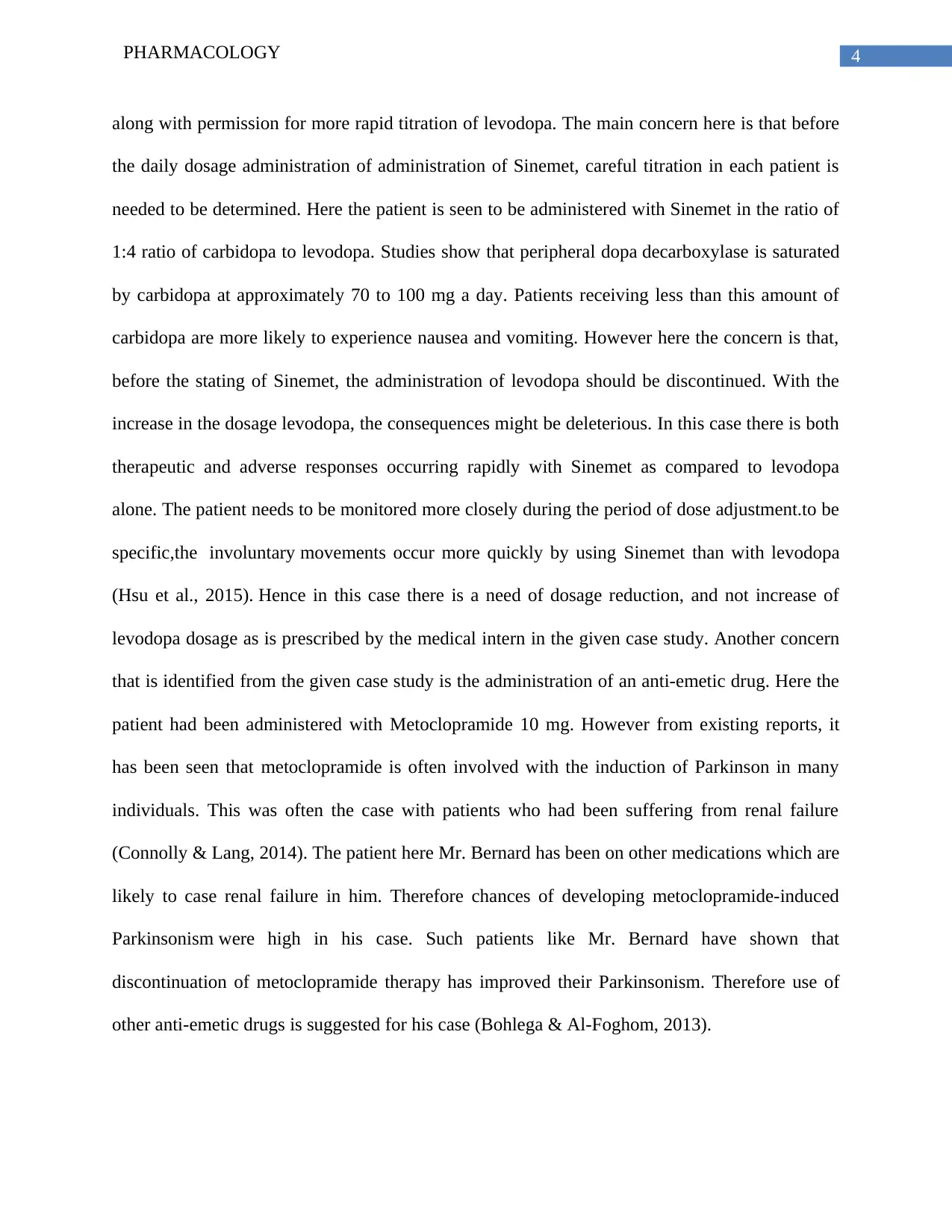
4PHARMACOLOGY
along with permission for more rapid titration of levodopa. The main concern here is that before
the daily dosage administration of administration of Sinemet, careful titration in each patient is
needed to be determined. Here the patient is seen to be administered with Sinemet in the ratio of
1:4 ratio of carbidopa to levodopa. Studies show that peripheral dopa decarboxylase is saturated
by carbidopa at approximately 70 to 100 mg a day. Patients receiving less than this amount of
carbidopa are more likely to experience nausea and vomiting. However here the concern is that,
before the stating of Sinemet, the administration of levodopa should be discontinued. With the
increase in the dosage levodopa, the consequences might be deleterious. In this case there is both
therapeutic and adverse responses occurring rapidly with Sinemet as compared to levodopa
alone. The patient needs to be monitored more closely during the period of dose adjustment.to be
specific,the involuntary movements occur more quickly by using Sinemet than with levodopa
(Hsu et al., 2015). Hence in this case there is a need of dosage reduction, and not increase of
levodopa dosage as is prescribed by the medical intern in the given case study. Another concern
that is identified from the given case study is the administration of an anti-emetic drug. Here the
patient had been administered with Metoclopramide 10 mg. However from existing reports, it
has been seen that metoclopramide is often involved with the induction of Parkinson in many
individuals. This was often the case with patients who had been suffering from renal failure
(Connolly & Lang, 2014). The patient here Mr. Bernard has been on other medications which are
likely to case renal failure in him. Therefore chances of developing metoclopramide-induced
Parkinsonism were high in his case. Such patients like Mr. Bernard have shown that
discontinuation of metoclopramide therapy has improved their Parkinsonism. Therefore use of
other anti-emetic drugs is suggested for his case (Bohlega & Al-Foghom, 2013).
along with permission for more rapid titration of levodopa. The main concern here is that before
the daily dosage administration of administration of Sinemet, careful titration in each patient is
needed to be determined. Here the patient is seen to be administered with Sinemet in the ratio of
1:4 ratio of carbidopa to levodopa. Studies show that peripheral dopa decarboxylase is saturated
by carbidopa at approximately 70 to 100 mg a day. Patients receiving less than this amount of
carbidopa are more likely to experience nausea and vomiting. However here the concern is that,
before the stating of Sinemet, the administration of levodopa should be discontinued. With the
increase in the dosage levodopa, the consequences might be deleterious. In this case there is both
therapeutic and adverse responses occurring rapidly with Sinemet as compared to levodopa
alone. The patient needs to be monitored more closely during the period of dose adjustment.to be
specific,the involuntary movements occur more quickly by using Sinemet than with levodopa
(Hsu et al., 2015). Hence in this case there is a need of dosage reduction, and not increase of
levodopa dosage as is prescribed by the medical intern in the given case study. Another concern
that is identified from the given case study is the administration of an anti-emetic drug. Here the
patient had been administered with Metoclopramide 10 mg. However from existing reports, it
has been seen that metoclopramide is often involved with the induction of Parkinson in many
individuals. This was often the case with patients who had been suffering from renal failure
(Connolly & Lang, 2014). The patient here Mr. Bernard has been on other medications which are
likely to case renal failure in him. Therefore chances of developing metoclopramide-induced
Parkinsonism were high in his case. Such patients like Mr. Bernard have shown that
discontinuation of metoclopramide therapy has improved their Parkinsonism. Therefore use of
other anti-emetic drugs is suggested for his case (Bohlega & Al-Foghom, 2013).
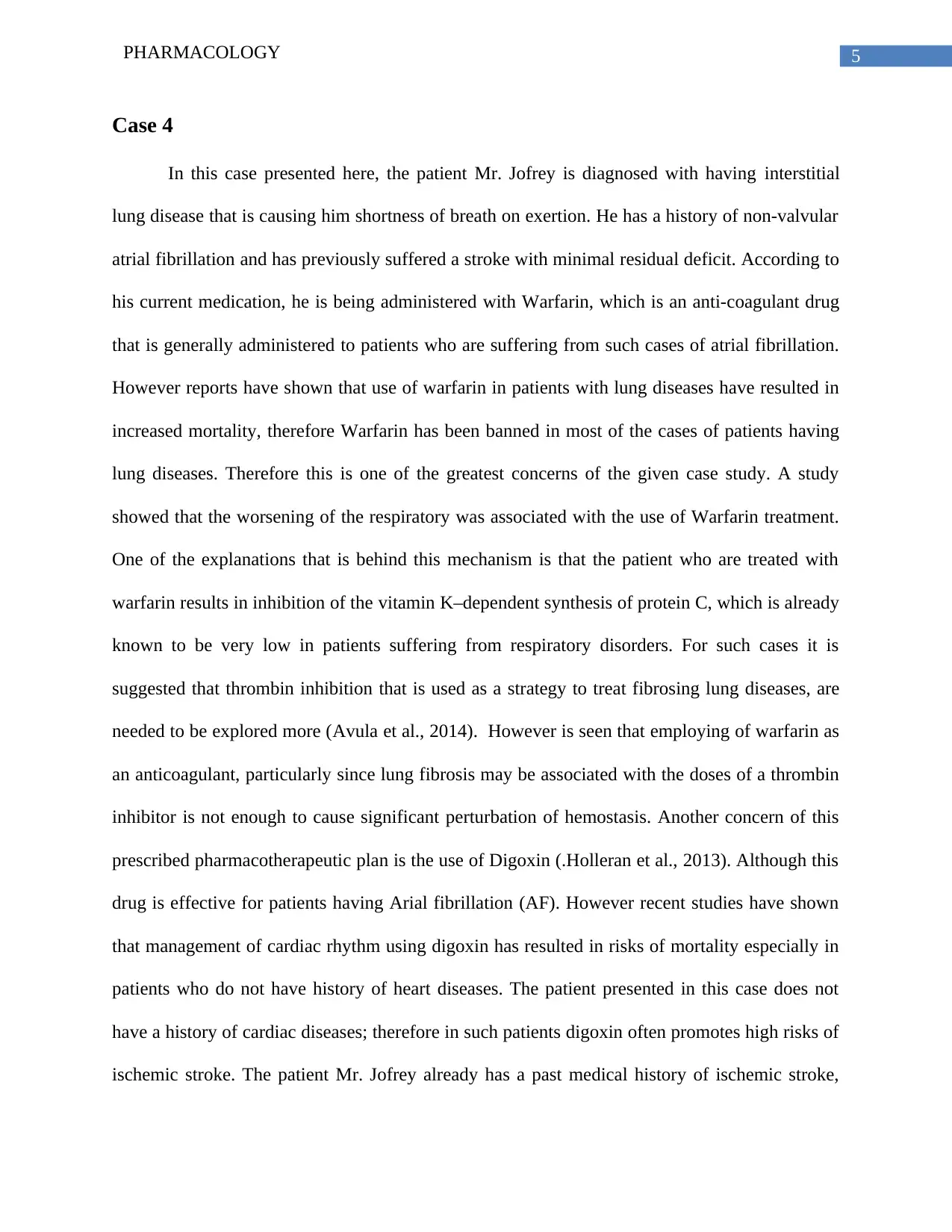
5PHARMACOLOGY
Case 4
In this case presented here, the patient Mr. Jofrey is diagnosed with having interstitial
lung disease that is causing him shortness of breath on exertion. He has a history of non-valvular
atrial fibrillation and has previously suffered a stroke with minimal residual deficit. According to
his current medication, he is being administered with Warfarin, which is an anti-coagulant drug
that is generally administered to patients who are suffering from such cases of atrial fibrillation.
However reports have shown that use of warfarin in patients with lung diseases have resulted in
increased mortality, therefore Warfarin has been banned in most of the cases of patients having
lung diseases. Therefore this is one of the greatest concerns of the given case study. A study
showed that the worsening of the respiratory was associated with the use of Warfarin treatment.
One of the explanations that is behind this mechanism is that the patient who are treated with
warfarin results in inhibition of the vitamin K–dependent synthesis of protein C, which is already
known to be very low in patients suffering from respiratory disorders. For such cases it is
suggested that thrombin inhibition that is used as a strategy to treat fibrosing lung diseases, are
needed to be explored more (Avula et al., 2014). However is seen that employing of warfarin as
an anticoagulant, particularly since lung fibrosis may be associated with the doses of a thrombin
inhibitor is not enough to cause significant perturbation of hemostasis. Another concern of this
prescribed pharmacotherapeutic plan is the use of Digoxin (.Holleran et al., 2013). Although this
drug is effective for patients having Arial fibrillation (AF). However recent studies have shown
that management of cardiac rhythm using digoxin has resulted in risks of mortality especially in
patients who do not have history of heart diseases. The patient presented in this case does not
have a history of cardiac diseases; therefore in such patients digoxin often promotes high risks of
ischemic stroke. The patient Mr. Jofrey already has a past medical history of ischemic stroke,
Case 4
In this case presented here, the patient Mr. Jofrey is diagnosed with having interstitial
lung disease that is causing him shortness of breath on exertion. He has a history of non-valvular
atrial fibrillation and has previously suffered a stroke with minimal residual deficit. According to
his current medication, he is being administered with Warfarin, which is an anti-coagulant drug
that is generally administered to patients who are suffering from such cases of atrial fibrillation.
However reports have shown that use of warfarin in patients with lung diseases have resulted in
increased mortality, therefore Warfarin has been banned in most of the cases of patients having
lung diseases. Therefore this is one of the greatest concerns of the given case study. A study
showed that the worsening of the respiratory was associated with the use of Warfarin treatment.
One of the explanations that is behind this mechanism is that the patient who are treated with
warfarin results in inhibition of the vitamin K–dependent synthesis of protein C, which is already
known to be very low in patients suffering from respiratory disorders. For such cases it is
suggested that thrombin inhibition that is used as a strategy to treat fibrosing lung diseases, are
needed to be explored more (Avula et al., 2014). However is seen that employing of warfarin as
an anticoagulant, particularly since lung fibrosis may be associated with the doses of a thrombin
inhibitor is not enough to cause significant perturbation of hemostasis. Another concern of this
prescribed pharmacotherapeutic plan is the use of Digoxin (.Holleran et al., 2013). Although this
drug is effective for patients having Arial fibrillation (AF). However recent studies have shown
that management of cardiac rhythm using digoxin has resulted in risks of mortality especially in
patients who do not have history of heart diseases. The patient presented in this case does not
have a history of cardiac diseases; therefore in such patients digoxin often promotes high risks of
ischemic stroke. The patient Mr. Jofrey already has a past medical history of ischemic stroke,
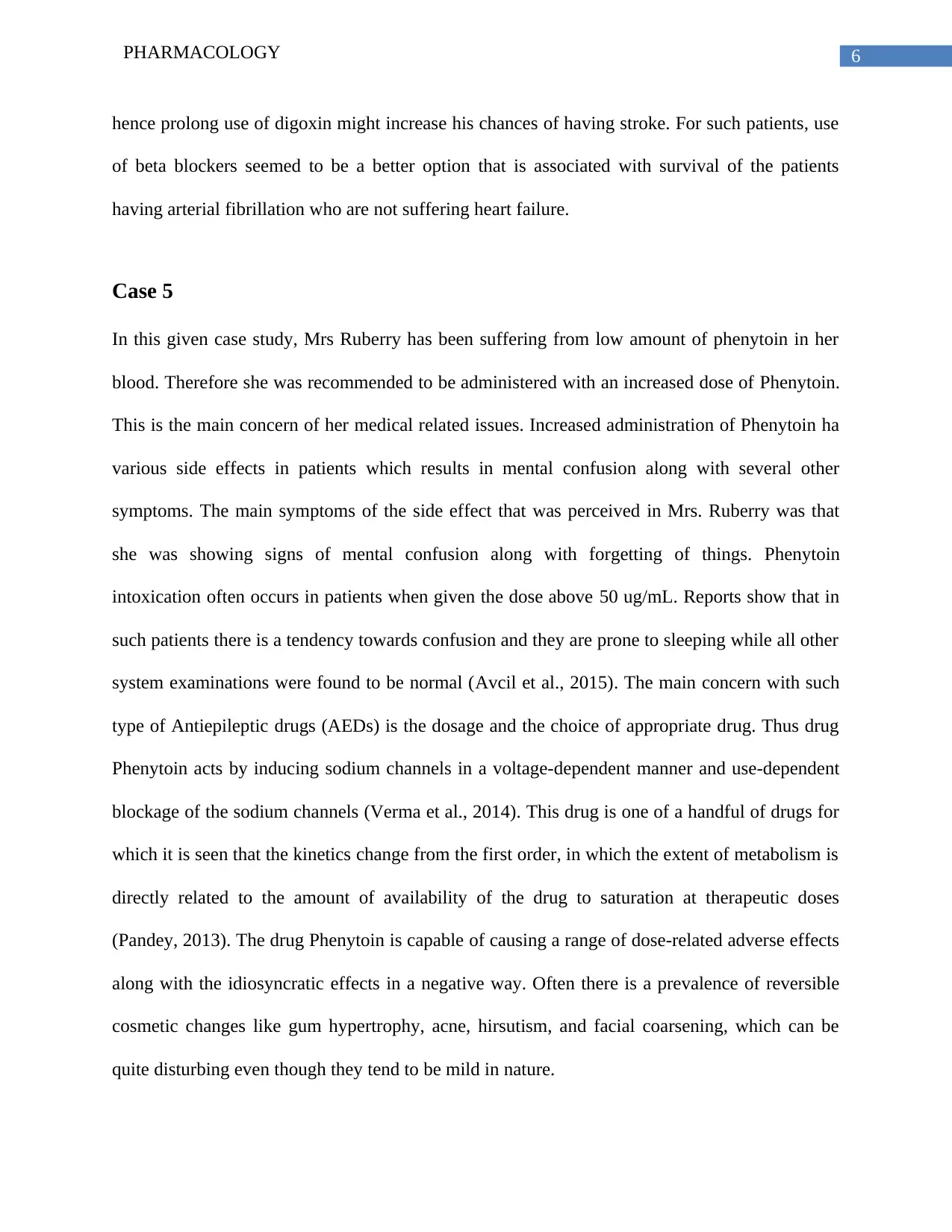
6PHARMACOLOGY
hence prolong use of digoxin might increase his chances of having stroke. For such patients, use
of beta blockers seemed to be a better option that is associated with survival of the patients
having arterial fibrillation who are not suffering heart failure.
Case 5
In this given case study, Mrs Ruberry has been suffering from low amount of phenytoin in her
blood. Therefore she was recommended to be administered with an increased dose of Phenytoin.
This is the main concern of her medical related issues. Increased administration of Phenytoin ha
various side effects in patients which results in mental confusion along with several other
symptoms. The main symptoms of the side effect that was perceived in Mrs. Ruberry was that
she was showing signs of mental confusion along with forgetting of things. Phenytoin
intoxication often occurs in patients when given the dose above 50 ug/mL. Reports show that in
such patients there is a tendency towards confusion and they are prone to sleeping while all other
system examinations were found to be normal (Avcil et al., 2015). The main concern with such
type of Antiepileptic drugs (AEDs) is the dosage and the choice of appropriate drug. Thus drug
Phenytoin acts by inducing sodium channels in a voltage-dependent manner and use-dependent
blockage of the sodium channels (Verma et al., 2014). This drug is one of a handful of drugs for
which it is seen that the kinetics change from the first order, in which the extent of metabolism is
directly related to the amount of availability of the drug to saturation at therapeutic doses
(Pandey, 2013). The drug Phenytoin is capable of causing a range of dose-related adverse effects
along with the idiosyncratic effects in a negative way. Often there is a prevalence of reversible
cosmetic changes like gum hypertrophy, acne, hirsutism, and facial coarsening, which can be
quite disturbing even though they tend to be mild in nature.
hence prolong use of digoxin might increase his chances of having stroke. For such patients, use
of beta blockers seemed to be a better option that is associated with survival of the patients
having arterial fibrillation who are not suffering heart failure.
Case 5
In this given case study, Mrs Ruberry has been suffering from low amount of phenytoin in her
blood. Therefore she was recommended to be administered with an increased dose of Phenytoin.
This is the main concern of her medical related issues. Increased administration of Phenytoin ha
various side effects in patients which results in mental confusion along with several other
symptoms. The main symptoms of the side effect that was perceived in Mrs. Ruberry was that
she was showing signs of mental confusion along with forgetting of things. Phenytoin
intoxication often occurs in patients when given the dose above 50 ug/mL. Reports show that in
such patients there is a tendency towards confusion and they are prone to sleeping while all other
system examinations were found to be normal (Avcil et al., 2015). The main concern with such
type of Antiepileptic drugs (AEDs) is the dosage and the choice of appropriate drug. Thus drug
Phenytoin acts by inducing sodium channels in a voltage-dependent manner and use-dependent
blockage of the sodium channels (Verma et al., 2014). This drug is one of a handful of drugs for
which it is seen that the kinetics change from the first order, in which the extent of metabolism is
directly related to the amount of availability of the drug to saturation at therapeutic doses
(Pandey, 2013). The drug Phenytoin is capable of causing a range of dose-related adverse effects
along with the idiosyncratic effects in a negative way. Often there is a prevalence of reversible
cosmetic changes like gum hypertrophy, acne, hirsutism, and facial coarsening, which can be
quite disturbing even though they tend to be mild in nature.
Paraphrase This Document
Need a fresh take? Get an instant paraphrase of this document with our AI Paraphraser
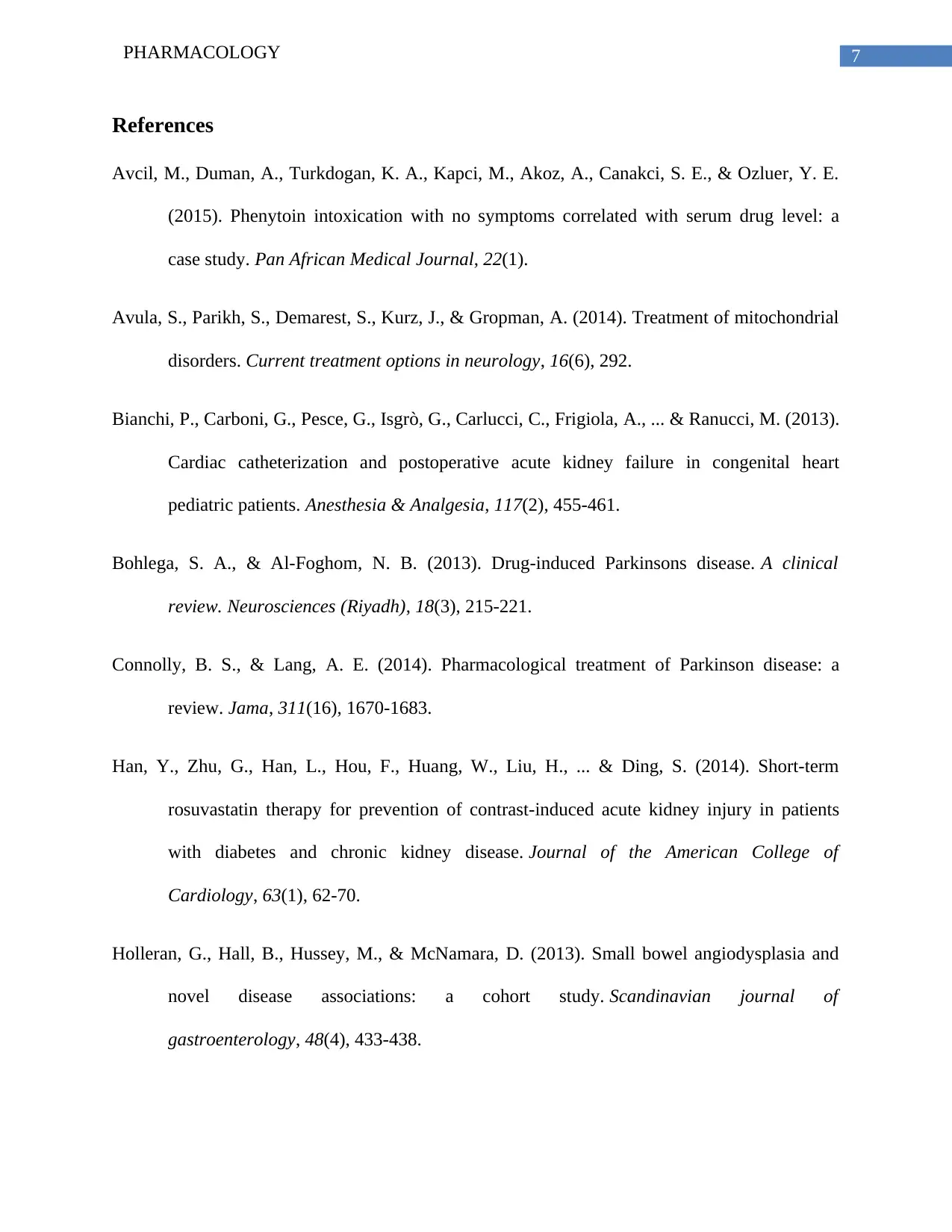
7PHARMACOLOGY
References
Avcil, M., Duman, A., Turkdogan, K. A., Kapci, M., Akoz, A., Canakci, S. E., & Ozluer, Y. E.
(2015). Phenytoin intoxication with no symptoms correlated with serum drug level: a
case study. Pan African Medical Journal, 22(1).
Avula, S., Parikh, S., Demarest, S., Kurz, J., & Gropman, A. (2014). Treatment of mitochondrial
disorders. Current treatment options in neurology, 16(6), 292.
Bianchi, P., Carboni, G., Pesce, G., Isgrò, G., Carlucci, C., Frigiola, A., ... & Ranucci, M. (2013).
Cardiac catheterization and postoperative acute kidney failure in congenital heart
pediatric patients. Anesthesia & Analgesia, 117(2), 455-461.
Bohlega, S. A., & Al-Foghom, N. B. (2013). Drug-induced Parkinsons disease. A clinical
review. Neurosciences (Riyadh), 18(3), 215-221.
Connolly, B. S., & Lang, A. E. (2014). Pharmacological treatment of Parkinson disease: a
review. Jama, 311(16), 1670-1683.
Han, Y., Zhu, G., Han, L., Hou, F., Huang, W., Liu, H., ... & Ding, S. (2014). Short-term
rosuvastatin therapy for prevention of contrast-induced acute kidney injury in patients
with diabetes and chronic kidney disease. Journal of the American College of
Cardiology, 63(1), 62-70.
Holleran, G., Hall, B., Hussey, M., & McNamara, D. (2013). Small bowel angiodysplasia and
novel disease associations: a cohort study. Scandinavian journal of
gastroenterology, 48(4), 433-438.
References
Avcil, M., Duman, A., Turkdogan, K. A., Kapci, M., Akoz, A., Canakci, S. E., & Ozluer, Y. E.
(2015). Phenytoin intoxication with no symptoms correlated with serum drug level: a
case study. Pan African Medical Journal, 22(1).
Avula, S., Parikh, S., Demarest, S., Kurz, J., & Gropman, A. (2014). Treatment of mitochondrial
disorders. Current treatment options in neurology, 16(6), 292.
Bianchi, P., Carboni, G., Pesce, G., Isgrò, G., Carlucci, C., Frigiola, A., ... & Ranucci, M. (2013).
Cardiac catheterization and postoperative acute kidney failure in congenital heart
pediatric patients. Anesthesia & Analgesia, 117(2), 455-461.
Bohlega, S. A., & Al-Foghom, N. B. (2013). Drug-induced Parkinsons disease. A clinical
review. Neurosciences (Riyadh), 18(3), 215-221.
Connolly, B. S., & Lang, A. E. (2014). Pharmacological treatment of Parkinson disease: a
review. Jama, 311(16), 1670-1683.
Han, Y., Zhu, G., Han, L., Hou, F., Huang, W., Liu, H., ... & Ding, S. (2014). Short-term
rosuvastatin therapy for prevention of contrast-induced acute kidney injury in patients
with diabetes and chronic kidney disease. Journal of the American College of
Cardiology, 63(1), 62-70.
Holleran, G., Hall, B., Hussey, M., & McNamara, D. (2013). Small bowel angiodysplasia and
novel disease associations: a cohort study. Scandinavian journal of
gastroenterology, 48(4), 433-438.
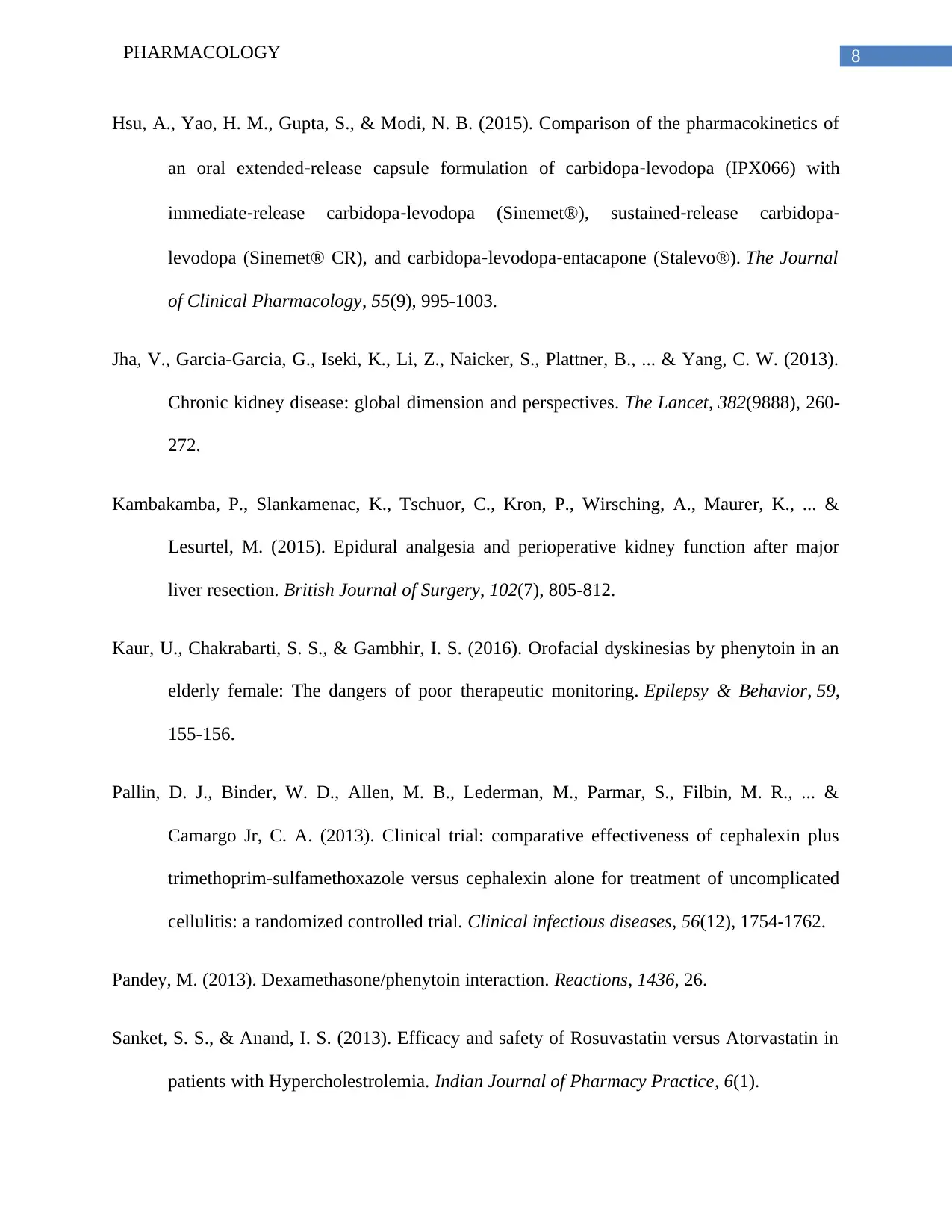
8PHARMACOLOGY
Hsu, A., Yao, H. M., Gupta, S., & Modi, N. B. (2015). Comparison of the pharmacokinetics of
an oral extended‐release capsule formulation of carbidopa‐levodopa (IPX066) with
immediate‐release carbidopa‐levodopa (Sinemet®), sustained‐release carbidopa‐
levodopa (Sinemet® CR), and carbidopa‐levodopa‐entacapone (Stalevo®). The Journal
of Clinical Pharmacology, 55(9), 995-1003.
Jha, V., Garcia-Garcia, G., Iseki, K., Li, Z., Naicker, S., Plattner, B., ... & Yang, C. W. (2013).
Chronic kidney disease: global dimension and perspectives. The Lancet, 382(9888), 260-
272.
Kambakamba, P., Slankamenac, K., Tschuor, C., Kron, P., Wirsching, A., Maurer, K., ... &
Lesurtel, M. (2015). Epidural analgesia and perioperative kidney function after major
liver resection. British Journal of Surgery, 102(7), 805-812.
Kaur, U., Chakrabarti, S. S., & Gambhir, I. S. (2016). Orofacial dyskinesias by phenytoin in an
elderly female: The dangers of poor therapeutic monitoring. Epilepsy & Behavior, 59,
155-156.
Pallin, D. J., Binder, W. D., Allen, M. B., Lederman, M., Parmar, S., Filbin, M. R., ... &
Camargo Jr, C. A. (2013). Clinical trial: comparative effectiveness of cephalexin plus
trimethoprim-sulfamethoxazole versus cephalexin alone for treatment of uncomplicated
cellulitis: a randomized controlled trial. Clinical infectious diseases, 56(12), 1754-1762.
Pandey, M. (2013). Dexamethasone/phenytoin interaction. Reactions, 1436, 26.
Sanket, S. S., & Anand, I. S. (2013). Efficacy and safety of Rosuvastatin versus Atorvastatin in
patients with Hypercholestrolemia. Indian Journal of Pharmacy Practice, 6(1).
Hsu, A., Yao, H. M., Gupta, S., & Modi, N. B. (2015). Comparison of the pharmacokinetics of
an oral extended‐release capsule formulation of carbidopa‐levodopa (IPX066) with
immediate‐release carbidopa‐levodopa (Sinemet®), sustained‐release carbidopa‐
levodopa (Sinemet® CR), and carbidopa‐levodopa‐entacapone (Stalevo®). The Journal
of Clinical Pharmacology, 55(9), 995-1003.
Jha, V., Garcia-Garcia, G., Iseki, K., Li, Z., Naicker, S., Plattner, B., ... & Yang, C. W. (2013).
Chronic kidney disease: global dimension and perspectives. The Lancet, 382(9888), 260-
272.
Kambakamba, P., Slankamenac, K., Tschuor, C., Kron, P., Wirsching, A., Maurer, K., ... &
Lesurtel, M. (2015). Epidural analgesia and perioperative kidney function after major
liver resection. British Journal of Surgery, 102(7), 805-812.
Kaur, U., Chakrabarti, S. S., & Gambhir, I. S. (2016). Orofacial dyskinesias by phenytoin in an
elderly female: The dangers of poor therapeutic monitoring. Epilepsy & Behavior, 59,
155-156.
Pallin, D. J., Binder, W. D., Allen, M. B., Lederman, M., Parmar, S., Filbin, M. R., ... &
Camargo Jr, C. A. (2013). Clinical trial: comparative effectiveness of cephalexin plus
trimethoprim-sulfamethoxazole versus cephalexin alone for treatment of uncomplicated
cellulitis: a randomized controlled trial. Clinical infectious diseases, 56(12), 1754-1762.
Pandey, M. (2013). Dexamethasone/phenytoin interaction. Reactions, 1436, 26.
Sanket, S. S., & Anand, I. S. (2013). Efficacy and safety of Rosuvastatin versus Atorvastatin in
patients with Hypercholestrolemia. Indian Journal of Pharmacy Practice, 6(1).

9PHARMACOLOGY
Verma, R., Kumar, S., Biyani, S., & Singh, A. (2014). Opsoclonus–Myoclonus syndrome
induced by phenytoin intoxication. Journal of neurosciences in rural practice, 5(Suppl
1), S109.
Verma, R., Kumar, S., Biyani, S., & Singh, A. (2014). Opsoclonus–Myoclonus syndrome
induced by phenytoin intoxication. Journal of neurosciences in rural practice, 5(Suppl
1), S109.
1 out of 10
Related Documents
Your All-in-One AI-Powered Toolkit for Academic Success.
+13062052269
info@desklib.com
Available 24*7 on WhatsApp / Email
![[object Object]](/_next/static/media/star-bottom.7253800d.svg)
Unlock your academic potential
© 2024 | Zucol Services PVT LTD | All rights reserved.




